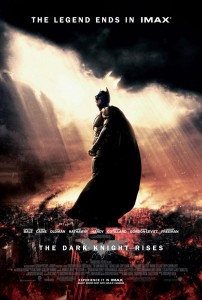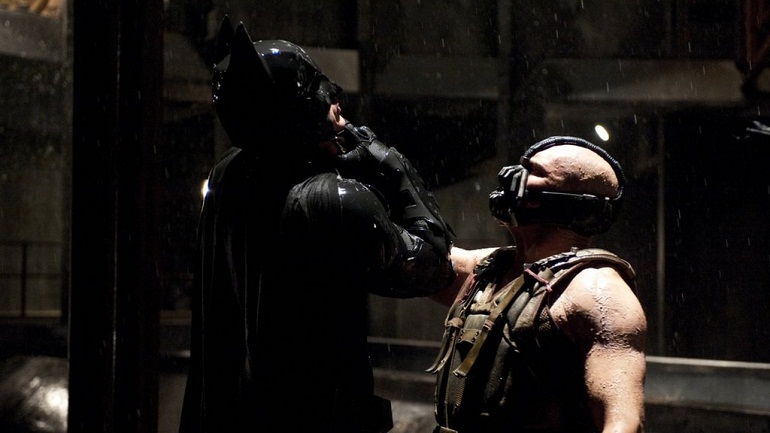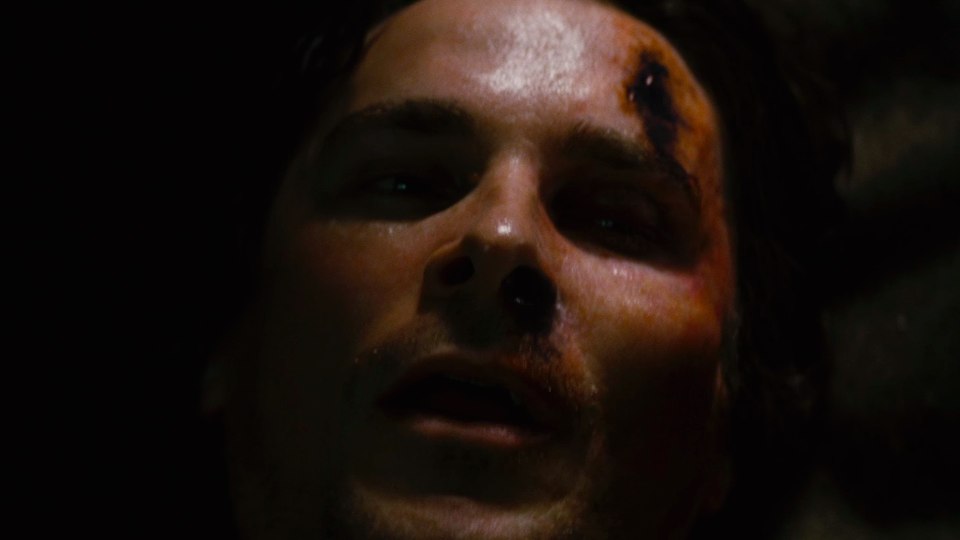
****
Just about everything imaginable has been said about The Dark Knight Rises since its release last year, enough to stretch hyperbole to both ends of its excruciating spectrum. For dedicated fans, it’s the greatest film of all time, to Nolanphobes it’s the worst, and to casuals it was loud, big and occasionally as indecipherable as Bane’s muffle-murmur. The consensus leans just about towards the positive, with enough critical weight and financial fruition to take it into the realms of super-success and, rightfully, hugely respectable epic filmmaking that like its predecessor transcends the niche of superhero fiction and takes a rightful place among Hollywood’s biggest hitters. What you likely have not heard about the trilogy climax is that it is astonishing storytelling built on the very simple, very effective theme of overcoming debilitating mental strife, a symbolic journey taking in shadowy world conspiracies and nuclear bombs to express the ability of anyone to face that darkest of demon – depression – and emerge triumphant and happy on the other side.
There still exists a general ignorance and misunderstanding of exactly what depression is, and it doesn’t help that the word itself is one of the most misused in the English language. Feeling sad does not constitute depression, and neither does an extended spell without luck or cheer. Depression is effectively a disease of the mind, one that can strike anyone at any time, regardless of your class, background, social circle or experience, and boils down more to chemical imbalances and brain neurons than it does self-pity or surrender. It hits you like a sudden, shocking assault by the darkness itself, pitting you into a nightmare without end where every negative is amplified by a hundred, every positive torn asunder by the invading host of misery and turned into a warped image of doubt and undeserving. You become your own worst enemy, trying to fight off an invisible foe by turning your guns, swords and spears on your self, in the process losing everything that life has built you into. No longer will you laugh or smile, excitement dies away and is replaced by futility, fear and self-hatred. Much like with a disease, you will wither away and become a shell, a scant resemblance to your old self. In cinematic terms, it is the transition from Aliens’ happy ending to the horrific waking dream of Alien 3. So traumatic is the experience, it doesn’t feel real, and it doesn’t seem like it will ever end.
This, not masked men and shadowy leagues, is Bruce Wayne’s true antagonist in Rises, and an element which makes the final leg of his journey all the more poignant. When we catch up with him at the beginning of the film, the internal rot has already set in; the loss of his love, the chaotic mutation of his vision, everything that The Dark Knight had to throw at him has turned him into a recluse, confined to his quarters and wearing what Honest Trailers tactfully describe as a “gross depression beard”. He has, essentially, given up on life. This is hugely significant, since he previously had found the heart to overcome the death of his parents and turn it into a crusade of justice and righteousness. He has suffered too much, carried too much weight, and is now in the quandary. His refusal to move on from Rachel Dawes’ murder reveals a darkly malignant, oozing degree of self-punishment, guilt fueling what he feels is deserved misery, combined with the all too true potency of self-doubt and loathing. As he says to Alfred in the early stages, there is nothing for him ‘out there’. When Alfred leaves and the Wayne Enterprises assets are stripped from him, it synchronizes with Bruce’s feeling that he is utterly alone.
The emergence of Bane and a new threat to Gotham seems to rouse Bruce back into life, giving him resolve to fight on. But as his warden is all too keen to point out, there is something perverse in Bruce seeing the cowl as his only response and fate. It represents many things, but notably among them danger and sacrifice, dedication to legend and legacy over self. By putting on the suit, he is neglecting the orphaned Wayne boy and pouring all his energy into an alter ego which knows no emotion, nor pursuit of happiness. The darkness has weakened him also and he is no longer as sharp, as fast or as strong as he once was. His destruction at the hands of Bane has two meanings, one of them worn on the face of the enemy, the other clear from his premature return to the fold. He has set himself up for a self-fulfilling prophecy in taking on such a foe, and is destined to fail, something which by now he almost expects. Not only has he failed to win, he has actually made things worse, giving up his armory to Bane and leaving Gotham defenseless. His imprisonment in the pit starts the new, decisive stage of his journey, one he would always have to face if he had ever hoped to become complete once more. The parallels between Bane and Batman are visible enough not to be dismissed as coincidental, right down to the name (‘Bruce wAyNE’) and his iconic mask (covering the one portion of his face that the Batman cowl does not). Also think back to the stunning prologue, and how the final shot of Bane and Dr Pavel dragged on a rope through midair resembles a near identical image of Batman and Lau doing the same during The Dark Knight. Bane, a mirror darkly image to Bruce, represents the internal enemy that will stalk the hero’s every step; he is not the League of Shadows, he IS the depression.
A lesson firmly fired home by the ultimate, conclusive match decider. While Bane is tearing up Gotham and laying waste to everything that matters to Bruce, our hero is stuck in a hopeless dirge at the bottom of the hole in the ground, tortured by false hope and the despair of failure. If he gives up, a palpably tempting choice, all is lost forever. Fighting on, making the climb, and finally facing his demons head on is the only way to survive. When he ascends the pit, sans rope, he is cheered on by his fellow inmates, his subconscious tearfully screaming for him to escape. That final jump bears huge weight, perhaps the most of any part of the film. The resemblance between the pit and the well Bruce fell down as a boy is deliberate, and the lack of a father to rescue him is vital; nobody can save him from this fate, only he himself can bring it to an end. So to is the quite easy dichotomy of light and dark, hope at the end of the tunnel, marking Bruce’s passing back into mental wellbeing. The presence of bats is equally important, as it marks his eventual return to that previous state of mind, where he was clear headed enough to see his own fear as his tool. When he jumps, it is because he has shed the weight and the doubt, lightened himself to make the leap of faith in true belief that he can get better, find better, because he deserves it. The sick nature of depression means it almost becomes comforting, as if by clinging on to it you are protected from the harshness of life and the prospect of further pain. Letting it go can be the hardest part, much like that jump, but Bruce has finally found the resolve to do just that. Gotham City is his life, and it is in ruin, he must rise from the darkness to save it. So he does, and he does leap, and he makes it.
TV Tropes would describe what happens next as a ‘Crowning Moment of Awesome’. Now an unstoppable force for good and redemption, Bruce returns to his city and utterly overwhelms his enemies, burning through them and inspiring all around him. Facing Bane, his depression, a second time, he is more than ready. In fact, he is destined to win because Bane is no longer the figure of doom and fear he once was, he is simply an operable tumor. As Batman, as his shield, Bruce takes him on face to face and defeats him, notably doing so by breaking the mask, destroying the disparity between the two. Some have complained that Bane’s demise, obliterated by Catwoman, was too quick, too dismissive. It is actually quite revealing that the previously unbeatable dark demon tormenting Bruce’s soul is finally quashed anti-climactically, and also by the person who represents his future happiness, Selina Kyle. He has broken the depression, and now she arrives in his life to dispel it completely. By the time Bruce races after Talia (a conflict which itself is tied in both to betrayal and regrettable past history) to end the strife and save Gotham once and for all, the battle is already won. The damage done by the depression is significant, but fixable, and the end game sees him finally overcome the darkness and symbolically wrestle it out of his life where it explodes harmlessly.
The film’s conclusion marks Bruce’s recovery quite beautifully. His presence in the café with Selina, alive and well, shows that his struggle has culminated with the life of happiness he had previously denied himself. He smiles and looks relaxed, more comfortable than ever he has before. After all of the darkness weighing heavy on his soul, it is a fitting new lease. Furthermore, his passing of the torch to John Blake shows that he has learned to trust again, had regained his faith in others, and found that there are good people and inherent goodness to be found around him. He takes the time to show his recovery to the people who matter to him, Gordon and Alfred, men who played such a huge part in his life and suffered in his gloom. Even the erection of a statue to finally officially honor the batman is symbolic, as it shows a willingness to celebrate the dark knight’s achievements and virtue. Bruce has previously shrugged off and disdained of praise and affirmation, but now the thanks he receives are warmly taken. The inspirational effect that he has on others, particularly Deputy Commissioner Foley (who has given into despair and hopelessness until Batman comes back), shows just how much faith Bruce should have in himself. He hasn’t just earned his happy ending, he has always deserved it and has made it happen by the dint of the personal attributes he had forgotten about during his darkest days.
Symbolic and metaphorical, The Dark Knight Rises live up to its promise of making Batman face his greatest challenge and his worst enemy; it just happens to be himself, a battle which he needs to win to complete the journey from selfless hero and anger-fuelled warrior into hopeful, contented victor. In truth, he has never been that person since the night has mother and father lost their lives in a tragedy he has always blamed himself for. Yes, he used that burning hurt to power his war on injustice, but he has neglected his own soul. By finally overcoming his depression and saving Gotham for the last time, he has done enough, earned his redemption and found reason to a life that offers so much better than life or death scrapping and lethal morality plays. For those of us in the audience who know that most damaging of conflicts, it is truly inspirational.
This has been a Strange Interpretation.
Scott Patterson





